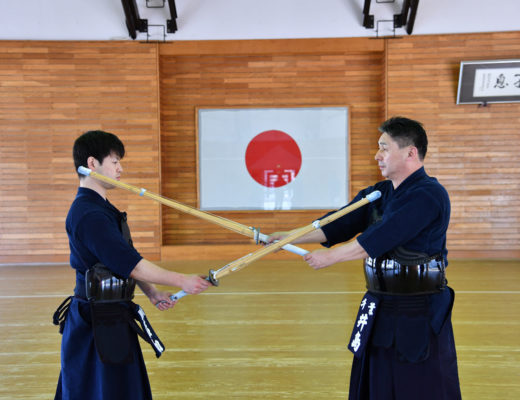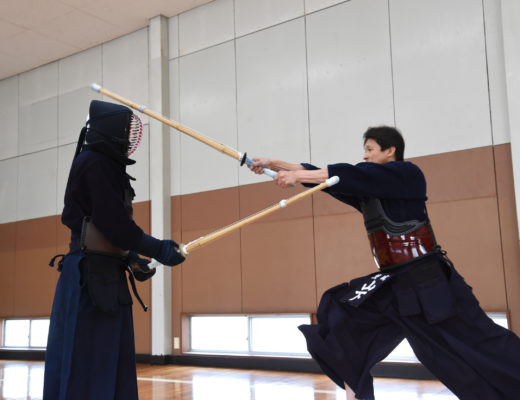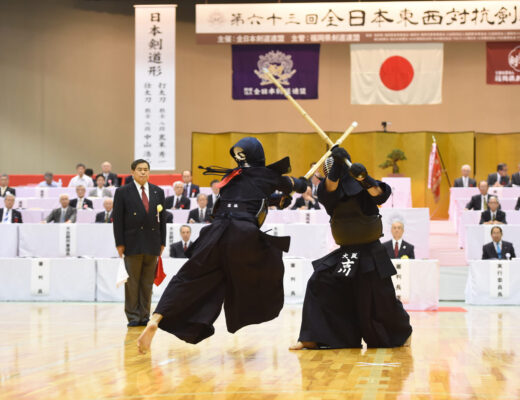2020.5 KENDOJIDAI
“It’s important to understand your opponent’s intentions and think of techniques that match those intentions”, says Nabeyama Takahiro Sensei. We asked Nabeyama Sensei about his techniques, based on his extensive experience as a competitor and instructor.

Nabeyama Takahiro, Kyoshi 8th Dan
Born in 1969 in Fukuoka prefecture. Started Kendo at Imajuku Kendo club, graduated from PL Gakuen High School and Tsukuba University. In his student days, he attained brilliant achievements such as 1st place in Inter-High Individual & Team competition and All Japan Student Team championship. After graduating from university, he took the path of researcher through the graduate school of the same university. Participated multiple times in the All Japan Kendo Championships, twice in the WKC and took the title in the All Japan Teachers’ Championships. Currently, Nabeyama is associate professor of physical education at the Tsukuba University and men’s coach of the Tsukuba University Kendo Club.
Does your opponent want to strike or is he afraid of being struck?
When I’m building up a technique, what I value most is my opponent’s thoughts and feelings. Is my opponent defensive and not wanting to be struck, or is he on the offense and looking to strike?
Depending on the situation, the way you attack will change, and the techniques you ultimately decide on will also change. There are people who prioritize the technique they feel like using themselves. I feel that too much of that doesn’t always lead to good results, so I try to set those feelings aside and use various avenues of Seme to strike.
During a mutual Seme with an opponent, the first thing I want to think about is to find out what the opponent’s intentions are. For example, in my case in Shiai, most of my opponents know my Men technique to be my speciality.
Then, from the moment I stand up from Sonkyo and confront my opponent, they will be wary of my Men technique. Understanding these intentions is very important when building up techniques.
As mentioned above, I don’t like deciding on techniques by personal preference, but each person has their own style. I specialize in Men techniques, so in the end, I am always thinking of ways to land a Men technique and what path of Seme to take. Kote and Do techniques are often the starting points for Ippon by Men and whether or not they become an Ippon, these techniques will lead to the final Men technique.
If you can land a strike in such a way that your opponent thinks, “I guess he was going for Men after all”, after he’s been struck, you will have been successful.
Whether your opponent wants to strike or doesn’t want to be struck, you can attack in a way that is appropriate to their intentions, which is your best bet to score an Ippon.
If your opponent does not want to be struck and you advance your Maai, it is difficult to find an opening and they will harden their defense. In such a case, you should read into their mind not wanting to be struck and then apply Seme from below or from the left side to pry open opportunity for Men techniques.
It’s good to read through the opponent’s defenses and change to Kote as well. When your opponent wants to strike, you should think of making your opponent freeze or capture the Debana timing and strike. This is the basic approach behind building up my techniques.

Look for Seme that your opponent can’t avoid
So, how do you actually go from assembling such a technique to actually performing it? Your superiority over your opponent’s mental state makes a huge difference. If you can create a state of mental superiority over your opponent, they will be defensive because they don’t want to get struck.
If you are in equal state of mind with your opponent, or he is winning, and you perform techniques there is a greater chance your opponent will catch an opportunity. Therefore, in such situations I make sure not to use Katsugi-waza and Renzoku-waza which tend to make your hands move upwards.
To give an example of a path of Seme, you can try jumping for Men from mutual Kamae and Issoku Itto range without first connecting with the left foot. Then your opponent will recognize the dangerous Maai and distance. You make his mind to be conscious of Men, then you can force him back mentally by striking Kote.
By sprinkling high and low attacks like this, your opponent’s caution is dispersed, and it makes it easier for your opponent to freeze. In this situation, attacking from below or showing a Katsugi technique will cause the opponent to react in some way. This is often a good opportunity to strike, and I try to instantly go all-in for Men in that situation.
If you decide to go for Kote, you must create a situation in which your opponent anticipates Men and his hands move upwards. I often apply Seme to men and advance my Maai, and when they raise their hands to defend I change to Kote.
It is important to note that it is too late to change to Kote after the opponent’s hands go up. In that situation, a fast opponent will just move his hands down again and there is a risk of counterstrikes
One more thing: If you are trying to catch your opponent freezing or a Debana timing, you need to be aware of your body structure. Particularly in Debana, it is important to advance your Maai in a way that makes your opponent want to strike. If your body leans forward, your opponent will feel the pressure and will start to defend, so I think it’s important to apply Seme without applying pressure as much as possible.
For this purpose, I practice parallel movement of the upper body to advance my Maai. If the opponent doesn’t know he is being attacked and freezes, I go straight for Men. If you feel that the opponent thinks you are merely moving forward and decides to strike, you can catch the Debana timing.
When you apply Seme and build up your techniques, it is important to not allow your opponent to avoid you. It is important to apply Seme in such a way that your opponent does not want his Men or Kote to be attacked and this should connect to Ippons.
The rest of this article is only available for Kendo Jidai International subscribers!





